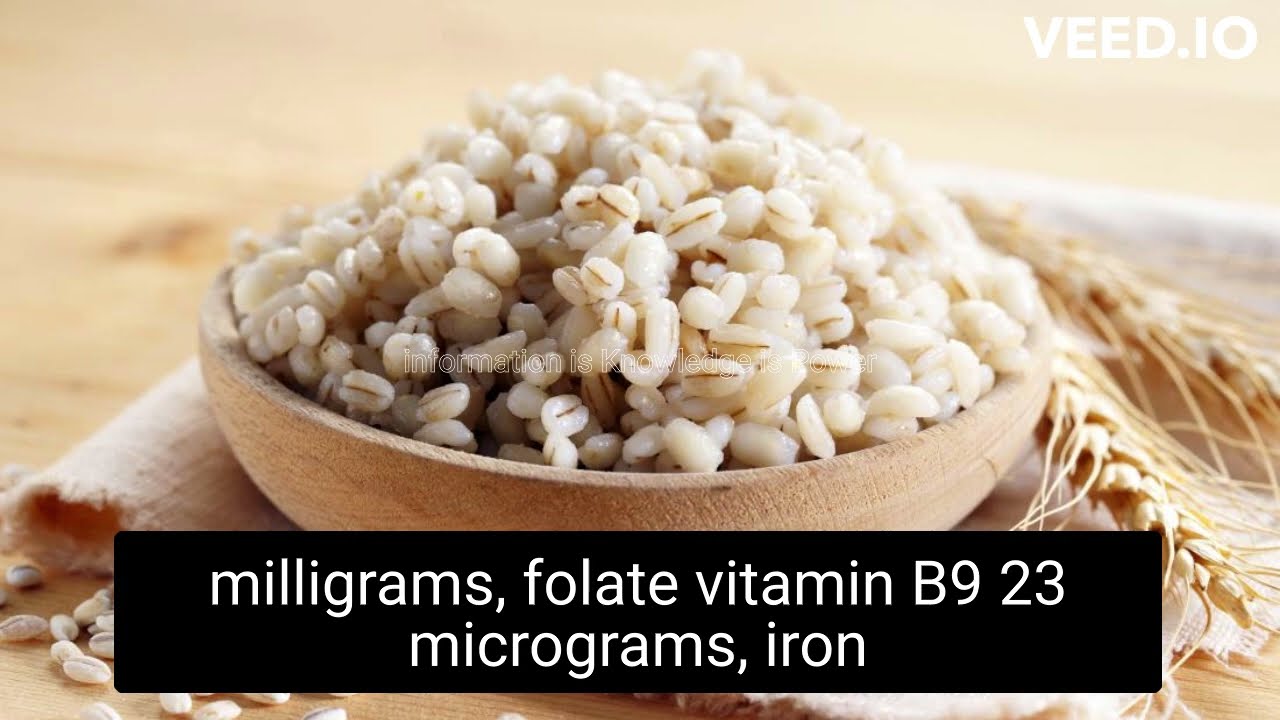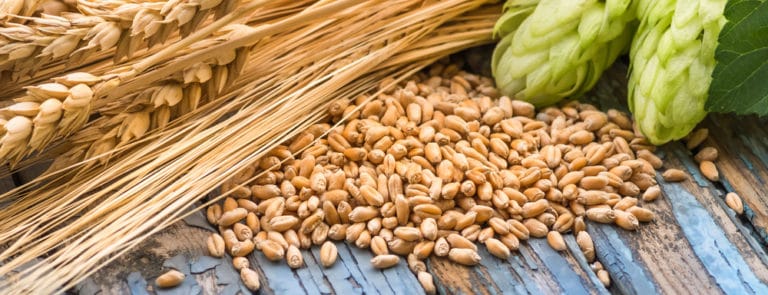Barley Nutrition Benefits, Facts, and Recipes

Barley, an ancient grain dating back centuries, is a versatile and nutritious food gaining popularity for its health benefits. From heart health to digestion and weight loss, barley nutrition offers a wide range of advantages. This comprehensive guide explores the nutritional makeup of barley, its health benefits, and practical tips for incorporating it into your diet.
What is Barley Nutrition?
Barley, scientifically known as Hordeum vulgare, is a cereal grain belonging to the grass family. Its consumption dates back to ancient civilizations, earning it the title of one of the oldest cultivated grains. It comes in various forms, including hulled barley, pearled barley, and barley flour.
High in Fiber
Barley is an excellent source of dietary fiber, both soluble and insoluble. Soluble fiber helps regulate blood sugar levels, while insoluble fiber aids digestion.
Rich in B Vitamins
Barley contains an array of B vitamins, including thiamine (B1), riboflavin (B2), niacin (B3), and pyridoxine (B6). These vitamins play crucial roles in energy metabolism, brain function, and skin health.
Good Source of Minerals
Barley is a natural source of several essential minerals, including magnesium, phosphorus, zinc, copper, iron, and selenium. These minerals contribute to bone health, immune function, and overall well-being.
Benefits of Barley Nutrition
The diverse nutritional profile of barley offers a range of health benefits.
Heart Health
Barley’s soluble fiber helps lower cholesterol levels, reducing the risk of heart disease. Additionally, its beta-glucan content aids in blood sugar regulation, benefiting heart health.
Digestive Health
The fiber in barley promotes healthy digestion. Soluble fiber absorbs water, forming a gel that slows down digestion and absorption of nutrients, leading to a feeling of fullness and potentially reducing the risk of obesity.
Weight Loss
Barley’s fiber content contributes to weight loss by increasing satiety and reducing overeating. It also contains resistant starch, a type of carbohydrate that resists digestion in the small intestine, contributing to weight management.
Anti-Inflammatory Properties
Barley contains antioxidants, including phenolic compounds and flavonoids, which have anti-inflammatory properties. These compounds help protect against chronic diseases, including heart disease and certain types of cancer.
Role in a Healthy Diet
A balanced diet should include a variety of whole grains, and barley is an excellent choice. Its nutritional profile makes it suitable for different dietary needs and health goals.
Consumption Guidelines
The recommended daily intake of whole grains is at least 3 servings for adults. A serving of barley is equivalent to 1/2 cup cooked barley or 1 cup whole-grain barley cereal.
How to Incorporate Barley into Your Diet
Integrating barley into your diet is simple and versatile. Here are some tips:
Side Dish
Cooked barley can be served as a side dish, similar to rice or quinoa. Add it to salads, soups, and stews for an extra boost of nutrition and texture.
Salads
Add cooked barley to salads for a hearty and nutritious meal. Barley salads can be prepared with various ingredients such as vegetables, nuts, seeds, and dressings.
Soups and Stews
Incorporate barley into soups and stews for a filling and flavorful meal. Barley absorbs the flavors of the broth, making it a satisfying addition.
Breakfast
Use barley as a base for breakfast porridge. Top it with fruits, nuts, and spices for a nutritious and delicious start to your day.
Barley Flour
Barley flour can be used as an alternative to wheat flour in baking. It has a slightly nutty flavor and adds texture to baked goods.
Barley Nutrition Facts You Need to Know
Here are some essential barley nutrition facts:
Nutrient Content
| Nutrient | Amount per 1/2 Cup Cooked Barley |
|---|---|
| Calories | 100 |
| Carbohydrates | 20 grams |
| Fiber | 5 grams |
| Protein | 3 grams |
| Fat | 1 gram |
Vitamin Content
| Vitamin | Amount per 1/2 Cup Cooked Barley |
|---|---|
| Thiamine (B1) | 0.2 mg |
| Riboflavin (B2) | 0.1 mg |
| Niacin (B3) | 1.3 mg |
| Pyridoxine (B6) | 0.3 mg |
Mineral Content
| Mineral | Amount per 1/2 Cup Cooked Barley |
|---|---|
| Magnesium | 31 mg |
| Phosphorus | 44 mg |
| Zinc | 1.1 mg |
| Copper | 0.1 mg |
| Iron | 2 mg |
| Selenium | 1.5 mcg |
The Role of Barley in a Healthy Diet
Barley’s nutritional profile makes it a valuable addition to a healthy diet. Its fiber content supports digestive health, weight loss, and heart health. The vitamins and minerals in barley contribute to overall well-being and can help meet daily nutrient recommendations.
Barley Nutrition vs Other Grains
Comparing barley nutrition with other grains reveals unique benefits and similarities:
Barley vs Rice
Barley has a lower glycemic index compared to white rice, meaning it causes a more gradual increase in blood sugar levels. Barley also contains more fiber than white rice, supporting digestive health and satiety.
Barley vs Quinoa
Barley is higher in fiber and protein compared to quinoa, making it a good choice for weight loss and satiety. However, quinoa contains more essential amino acids, providing a more complete protein source.
Barley vs Wheat
Barley contains less gluten than wheat, making it a suitable option for individuals with gluten sensitivities. It is also higher in fiber and certain minerals, such as magnesium and zinc.
Barley Nutrition for Weight Loss
Barley’s fiber content promotes weight loss by increasing satiety and reducing overeating. It also contains resistant starch, which contributes to weight management.
Fiber’s Role in Weight Loss
Fiber helps promote weight loss by slowing down digestion and absorption of nutrients, leading to a feeling of fullness and potentially reducing overeating.
Resistant Starch and Weight Loss
Resistant starch is a type of carbohydrate that resists digestion in the small intestine. It contributes to weight loss by promoting satiety and reducing the absorption of calories.
Barley Nutrition for Heart Health
The soluble fiber in barley helps lower cholesterol levels by preventing the absorption of dietary cholesterol. Additionally, its beta-glucan content aids in blood sugar regulation, benefiting heart health.
Soluble Fiber and Heart Health
Soluble fiber helps lower cholesterol levels by binding to cholesterol in the digestive tract and preventing its absorption.
Beta-Glucan and Heart Health
Beta-glucan is a type of soluble fiber found in barley. It has been shown to lower cholesterol levels and improve blood sugar control, reducing the risk of heart disease.
Barley Nutrition for Digestive Health
The fiber in barley promotes healthy digestion and prevents constipation. It also contains prebiotics, which feed the beneficial bacteria in the gut and promote gut health.
Fiber and Digestive Health
Fiber helps promote healthy digestion by adding bulk to stools and aiding their movement through the digestive tract, preventing constipation.
Prebiotics and Digestive Health
Prebiotics are non-digestible carbohydrates that feed the beneficial bacteria in the gut. They promote a healthy balance of gut bacteria, supporting gut health and overall well-being.
Barley Nutrition for Overall Wellness
Barley’s nutritional profile contributes to overall wellness, including skin health, energy levels, and a balanced mood.
Skin Health
Barley contains several vitamins and minerals that contribute to skin health. These nutrients support skin regeneration and help maintain a healthy complexion.
Energy Levels
The carbohydrates in barley provide a sustained source of energy, helping maintain energy levels and reducing fatigue.
Balanced Mood
The B vitamins in barley play a role in supporting a healthy mood and promoting mental well-being.
Conclusion
Barley is a nutritious and versatile grain that can be easily incorporated into a healthy diet. Its fiber content supports digestive health, weight loss, and heart health, while its vitamins and minerals contribute to overall wellness. By incorporating barley into your meals, you can reap the many benefits of this superfood and improve your overall health.
Foods to Avoid for Thyroid Patients
Foods High in Uric Acid Understanding the Link to Gout and How to Manage










